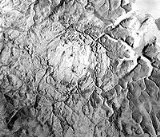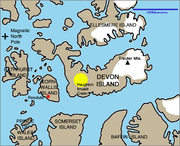
Haughton impact crater
Encyclopedia

Impact crater
In the broadest sense, the term impact crater can be applied to any depression, natural or manmade, resulting from the high velocity impact of a projectile with a larger body...
is located on Devon Island
Devon Island
Devon Island , claimed to be the largest uninhabited island on Earth, is located in Baffin Bay, Qikiqtaaluk Region, Nunavut, Canada. It is one of the larger members of the Canadian Arctic Archipelago, the second-largest of the Queen Elizabeth Islands, Canada's sixth largest island, and the 27th...
, Nunavut
Nunavut
Nunavut is the largest and newest federal territory of Canada; it was separated officially from the Northwest Territories on April 1, 1999, via the Nunavut Act and the Nunavut Land Claims Agreement Act, though the actual boundaries had been established in 1993...
in far northern Canada
Canada
Canada is a North American country consisting of ten provinces and three territories. Located in the northern part of the continent, it extends from the Atlantic Ocean in the east to the Pacific Ocean in the west, and northward into the Arctic Ocean...
. It is about 23 km (14.3 mi) in diameter and formed about 39 million years ago (late Eocene
Eocene
The Eocene Epoch, lasting from about 56 to 34 million years ago , is a major division of the geologic timescale and the second epoch of the Paleogene Period in the Cenozoic Era. The Eocene spans the time from the end of the Palaeocene Epoch to the beginning of the Oligocene Epoch. The start of the...
). The impacting object is estimated to have been approximately 2 km (1.2 mi) in diameter. Devon Island itself is composed of Paleozoic
Paleozoic
The Paleozoic era is the earliest of three geologic eras of the Phanerozoic eon, spanning from roughly...
shale
Shale
Shale is a fine-grained, clastic sedimentary rock composed of mud that is a mix of flakes of clay minerals and tiny fragments of other minerals, especially quartz and calcite. The ratio of clay to other minerals is variable. Shale is characterized by breaks along thin laminae or parallel layering...
and siltstone
Siltstone
Siltstone is a sedimentary rock which has a grain size in the silt range, finer than sandstone and coarser than claystones.- Description :As its name implies, it is primarily composed of silt sized particles, defined as grains 1/16 - 1/256 mm or 4 to 8 on the Krumbein phi scale...
overlying gneiss
Gneiss
Gneiss is a common and widely distributed type of rock formed by high-grade regional metamorphic processes from pre-existing formations that were originally either igneous or sedimentary rocks.-Etymology:...
ic bedrock
Bedrock
In stratigraphy, bedrock is the native consolidated rock underlying the surface of a terrestrial planet, usually the Earth. Above the bedrock is usually an area of broken and weathered unconsolidated rock in the basal subsoil...
. When the crater formed, the shale and siltstone were peeled back to expose the basement; material from as deep as 1700 m (5,577.4 ft) has been identified.
At 75° north latitude, it is one of the highest-latitude impact craters known. The temperature is below the freezing point of water for much of the year, and the limited vegetation is slow-growing, leading to very little weathering
Weathering
Weathering is the breaking down of rocks, soils and minerals as well as artificial materials through contact with the Earth's atmosphere, biota and waters...
. For this reason Haughton retains many geological features that lower-latitude craters lose to erosion
Erosion
Erosion is when materials are removed from the surface and changed into something else. It only works by hydraulic actions and transport of solids in the natural environment, and leads to the deposition of these materials elsewhere...
.

Breccia
Breccia is a rock composed of broken fragments of minerals or rock cemented together by a fine-grained matrix, that can be either similar to or different from the composition of the fragments....
(ejected rock which has fallen back into the impact zone and partially re-welded) that is permeated with permafrost
Permafrost
In geology, permafrost, cryotic soil or permafrost soil is soil at or below the freezing point of water for two or more years. Ice is not always present, as may be in the case of nonporous bedrock, but it frequently occurs and it may be in amounts exceeding the potential hydraulic saturation of...
, thus creating a close analog to what may be expected at crater sites on a cold, wet Mars
Mars
Mars is the fourth planet from the Sun in the Solar System. The planet is named after the Roman god of war, Mars. It is often described as the "Red Planet", as the iron oxide prevalent on its surface gives it a reddish appearance...
. The Mars Institute
Mars Institute
The Mars Institute is an international non-governmental organization created with the goals of advancing the scientific study and exploration of Mars, conducting high-quality, peer-reviewed research, and educating the public on the progress toward and benefits of Mars exploration. It was...
and SETI
SETI
The search for extraterrestrial intelligence is the collective name for a number of activities people undertake to search for intelligent extraterrestrial life. Some of the most well known projects are run by the SETI Institute. SETI projects use scientific methods to search for intelligent life...
operate the Haughton-Mars Project
Haughton-Mars Project
The Haughton–Mars Project is an international interdisciplinary field research project being carried out near the Haughton impact crater on Canada's northern Devon Island. human-centered computing studies are aimed at determining how human explorers might live and work on other planetary...
at this site, designed to test many of the challenges of life and work on Mars. The non-profit Mars Society
Mars Society
The Mars Society is an international space advocacy non-profit organization dedicated to promoting the human exploration and settlement of the planet Mars. It was founded by Robert Zubrin and others in 1998 and attracted the support of notable science fiction writers and filmmakers, including Kim...
also operates the Flashline Mars Arctic Research Station
Flashline Mars Arctic Research Station
The Flashline Mars Arctic Research Station is the first of two simulated Mars habitats established and maintained by the Mars Society.-Background:...
(FMARS
Flashline Mars Arctic Research Station
The Flashline Mars Arctic Research Station is the first of two simulated Mars habitats established and maintained by the Mars Society.-Background:...
) at this site and conducts similar research.

